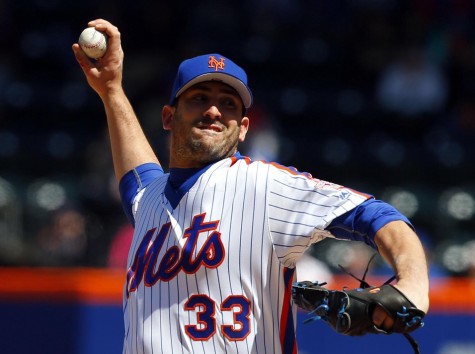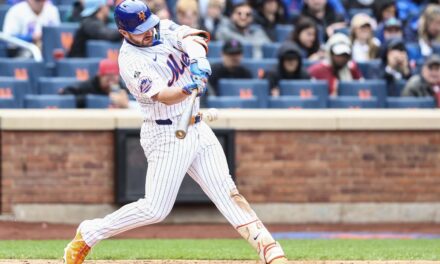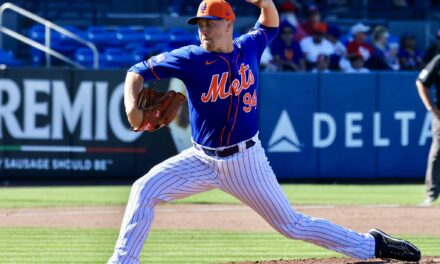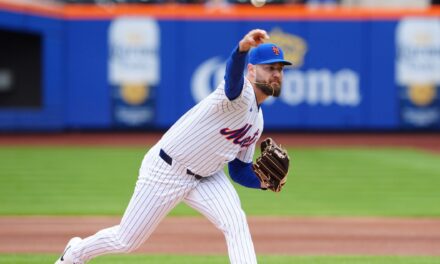
The New York Mets hitters were stunned once again by the Philadelphia Phillies in their 5-2 loss yesterday afternoon. More stunning was Matt Harvey’s pitch selection in key at-bats during the game.
Matt Harvey (L, 0-2) 6.0 IP, 3 R, 6 H, 3 SO, 2 BB
Harvey attacked Phillies hitters throwing 63 of 93 pitches for strikes, an above average 67.7% strike rate. Harvey got ahead of hitters throwing 18 of 25 first pitch strikes, an above average 72% first pitch strike rate. Harvey’s movement and command of his secondary pitches was solid considering the cooler air makes gripping and general feeling of the baseball more difficult. So, how did Harvey allow three runs against a Phillies lineup scoring a total of three runs in the previous two games?
Pitch selection.
On cold or cooler days in April, May and October, the advantage goes to the pitcher. Pitchers continuously move for their defensive half inning, keeping their body temperature high followed by staying warm on the bench during the offensive half inning. Conversely, hitters are predominately standing still in the cold, barren field for a defensive half inning and only hit on average every other offensive half inning. Due to the lack of movement, hitters are stiffer resulting in slower hands and hip/core rotation making it difficult for hitters to turn on inside fastballs.
Harvey threw a good amount of inside fastballs with successful results. Unfortunately, Harvey turned to off-speed pitches in many two strike counts when clearly the hitter was late on pitches and had no chance making solid contact against inside heat. Particularly, two instances come to mind:
- In the third inning, Harvey was ahead 0-2 against Phillies pitcher Jeremy Hellickson. Harvey attempted a 0-2 slider which missed over the plate allowing Hellickson to hit a single to right field moving Peter Bourjos to third base. Bourjos scored the next at-bat on a Freddy Galvis sacrifice fly to left field. If Harvey gets Hellickson out, Galvis flies out harmlessly to left field and Harvey retires the following two hitters by ground out, meaning Bourjos doesn’t pass second base let alone able to score.
- In the sixth inning, Odubel Herrera homered on a 1-2 slider over the right field fence. Understandably, Harvey threw an off-speed pitch after throwing three straight fastballs. However, the low and in slider is the wrong pitch selection. If the slider isn’t thrown low enough, it tends to be an easier pitch for a left-handed hitter to make contact with, which was the result. Instead, Harvey should have gone low and away out of the strike zone with a changeup, varying eye level and speed differential from his fastball and setting up Herrera for an inside fastball the following pitch. Even if Herrera anticipates a fastball, Herrera won’t be able to catch up with it for all the reasons above.
Other Notes
Another game, another healthy performance from David Wright. Aggressive swings all game culminated in a line-drive double into the right-center field gap. Additionally, Wright made another fluid defensive play, charging a weak ground ball to third base with the throw slightly low to first base negating what would have been a great play.
Yoenis Cespedes sixth inning home run was a beautiful missile into the left field bleachers. More beautiful was entirety the at-bat. Cespedes not only battled back from a 1-2 count to force a full 3-2 count but fought off four consecutive pitches low in the strike zone to force a home run bound eleventh pitch of the at-bat.
Stat of the Night
In 2015, Harvey started six games similarly, where he issued two or more walks while having six or less strikeouts. He amassed a 7.02 ERA in those starts compared to his 2.71 cumulative season ERA.
Follow Chris Zaccherio on Twitter @ziography for more Mets insight going beyond statistics.















